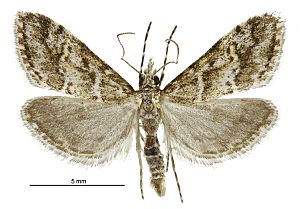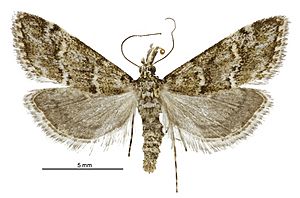Culladia strophaea facts for kids
Quick facts for kids Culladia strophaea |
|
|---|---|
 |
|
| male | |
 |
|
| female | |
| Scientific classification | |
| Synonyms | |
|
Culladia strophaea is a small moth that belongs to the family Crambidae. This moth is special because it is only found in New Zealand. Scientists are still working to fully understand its exact classification.
About This Moth's Name
This moth was first described in 1905 by a scientist named Edward Meyrick. He called it Argyria strophaea. He used moths collected by George Hudson in Wellington. Hudson even included pictures of this moth in his 1928 book about New Zealand's butterflies and moths.
Later, in 1973, another scientist, D. E. Gaskin, suggested that this moth should be placed in a different group called Culladia. This is why it is now often called Culladia strophaea. However, some scientists still debate this change. Because of this, you might also see it referred to as Argyria (s.l.) strophaea.
Where This Moth Lives
This moth is endemic to New Zealand, meaning it naturally lives nowhere else in the world. You can find Culladia strophaea in the North Island. It also lives in parts of the South Island, specifically in the Nelson and Westland areas.
Besides its first discovery place in Wellington, this moth has been seen in many other locations. These include Whakarewarewa, Raurimu, Whanganui, and Haruru Falls in the Bay of Islands. It has also been found near Lake Taupo, Bluff Hill in Napier, and at Lake Rotorua.
Life and Habits
The young moths, called larvae, have been found living in the soil. Adult Culladia strophaea moths are active and can be seen flying in January. Scientists have collected these moths using special lights. They use mercury vapour light traps and 15-watt UV light traps.
This moth often lives in rocky areas, like stony cuttings. You might find them near roadsides, especially close to forest habitats.

